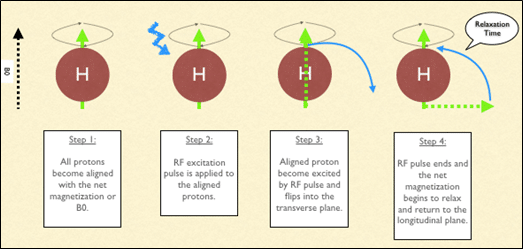When x-rays passed into the body, it casts shadow of the bones. A doctor can read x-ray film and diagnose. But the body is also made up of soft tissues, nerves, muscles, fluids. They cannot be detected using x-rays. The 'magnetic resonance imaging (MRI) gives the full picture.
Our body mostly contains water, we know each water molecule has one oxygen atom and two hydrogen atoms. Hydrogen atom is nothing but a single proton. So each water molecule has two single protons. Proton is positively charged and spins like earth and moon. When a charge spins, it acts like piece of magnet. Hence each water molecule is a magnet. (or 2 magnets) . These magnets are oriented in various directions normally.
A patient is put inside the MRI machine and a strong magnetic field is applied to the body. This field is a thousand times powerful than that of a fridge magnet. (Remember, no magnetic substance like keys, coins are allowed inside the MRI room). Now all the proton magnets (n the water component of a particular part of a body) are oriented and aligned in the direction of MRI machine's magnetic field.
Now, the machine sends some electromagnetic energy (high frequency) wave into the particular part of the body.
The spinning protons absorbs it and reverses its direction (flips its magnetic direction). When the external field is switched off, the protons return to its original state by emitting the same absorbed energy.
It is like; water is raised to the overhead tank by the water pump using electrical energy and stored. Once the value is opened it flows down using absorbed energy.
The amount of water content in a particular part of the body (say brain), energy released , value of returning to the normal state(protons). All these factors are interpreted by the computer software(MRI) and give us 2D or 3D image.
Note: Radiation risk is not there in MRI.
Resonance means same frequency energy is absorbed and released by the protons (H2O).
-------------------------------------------------------------------------------------------------------------------------

